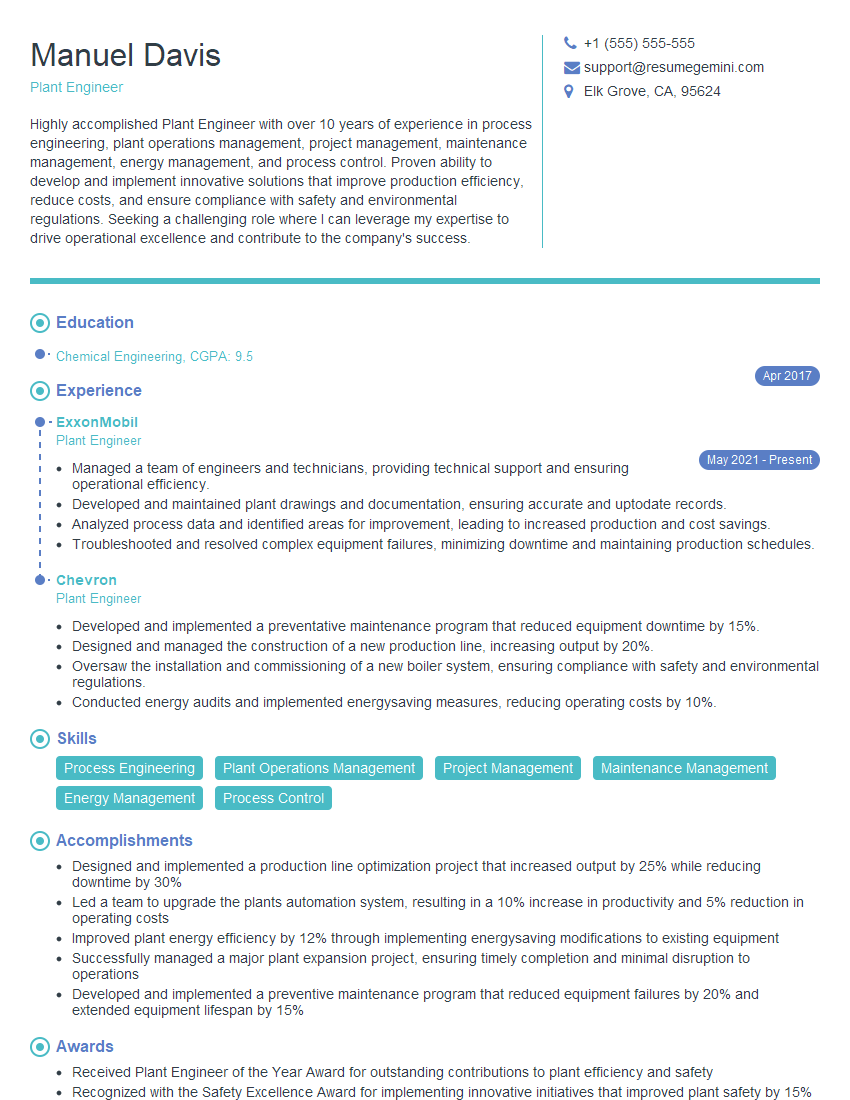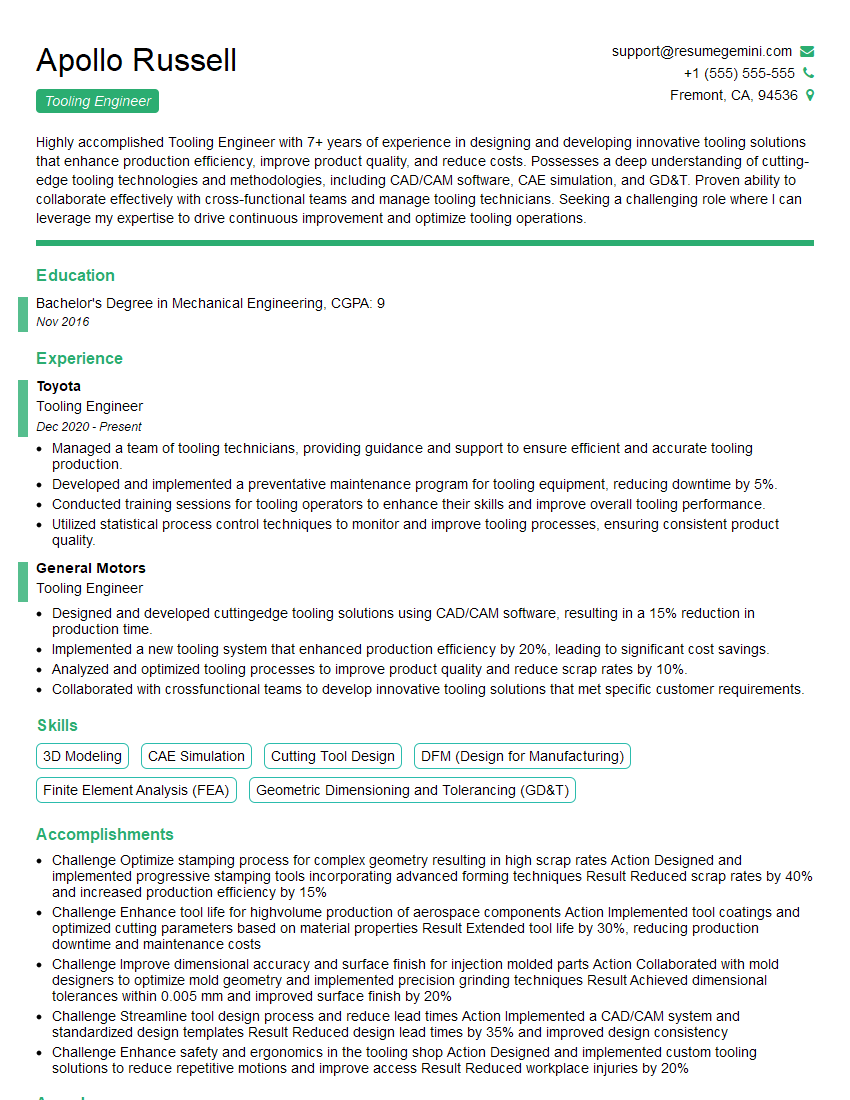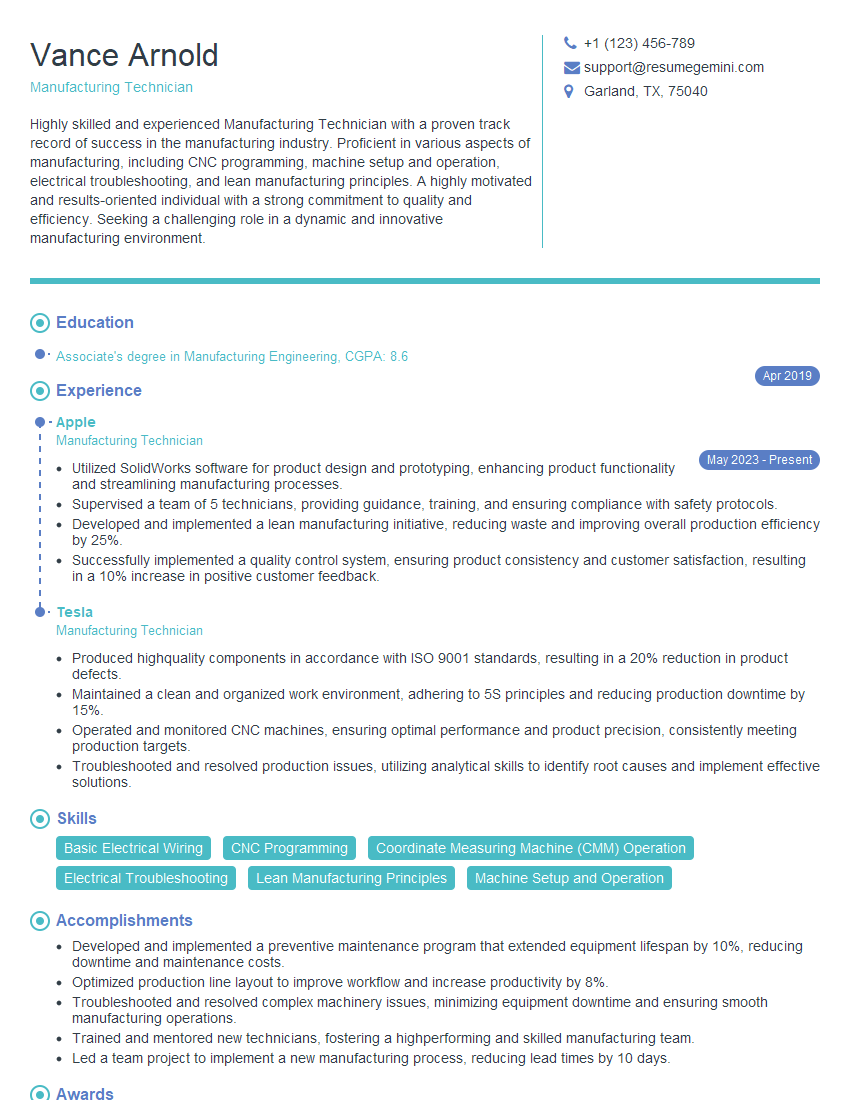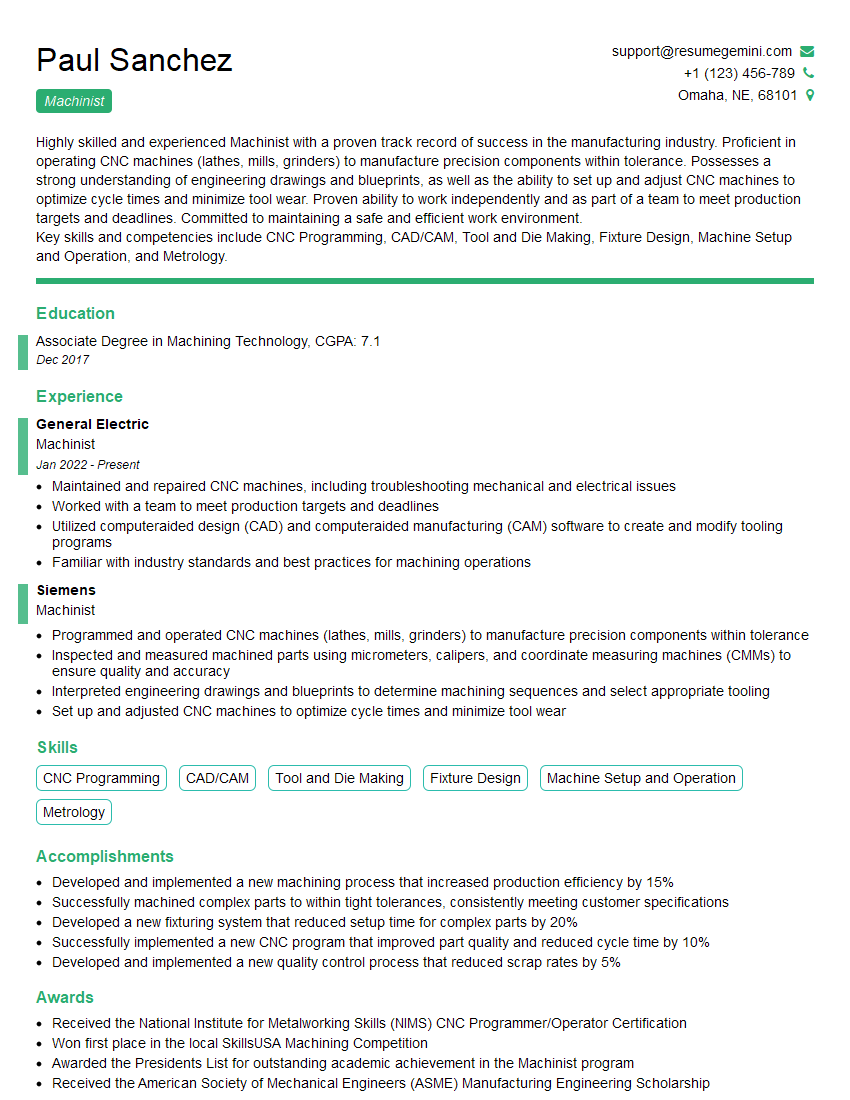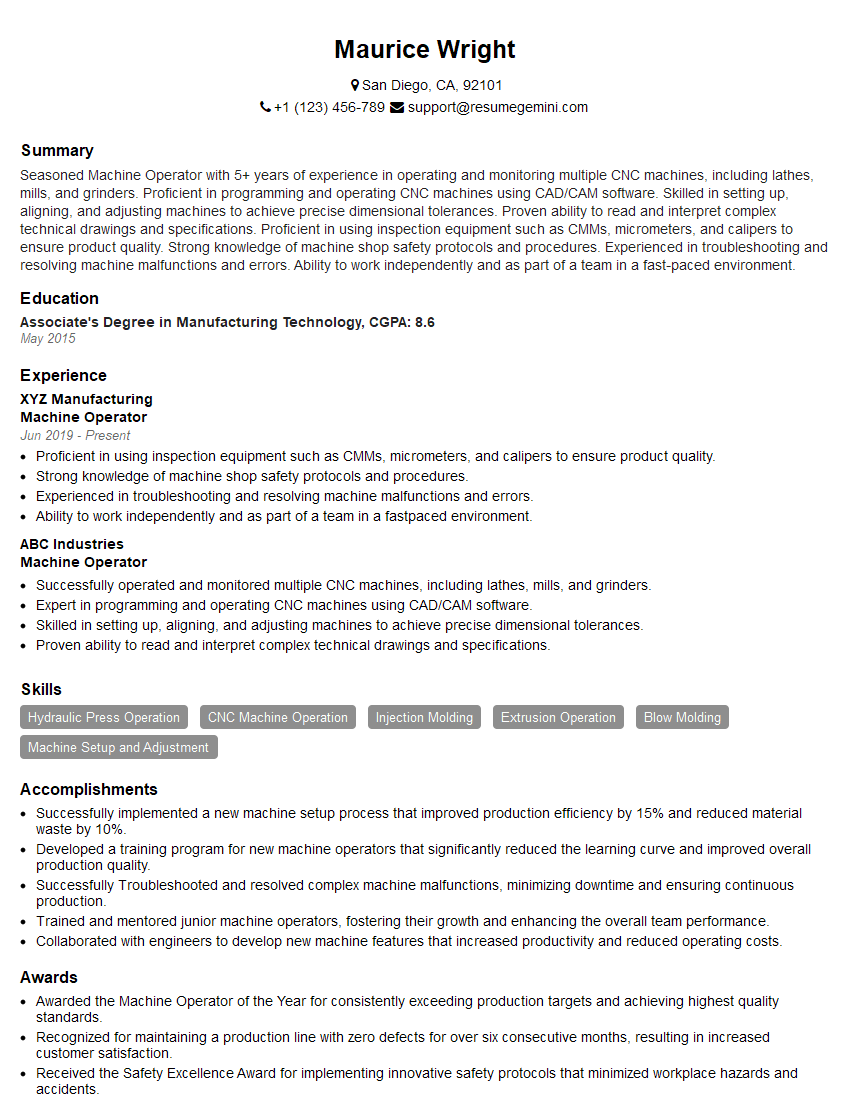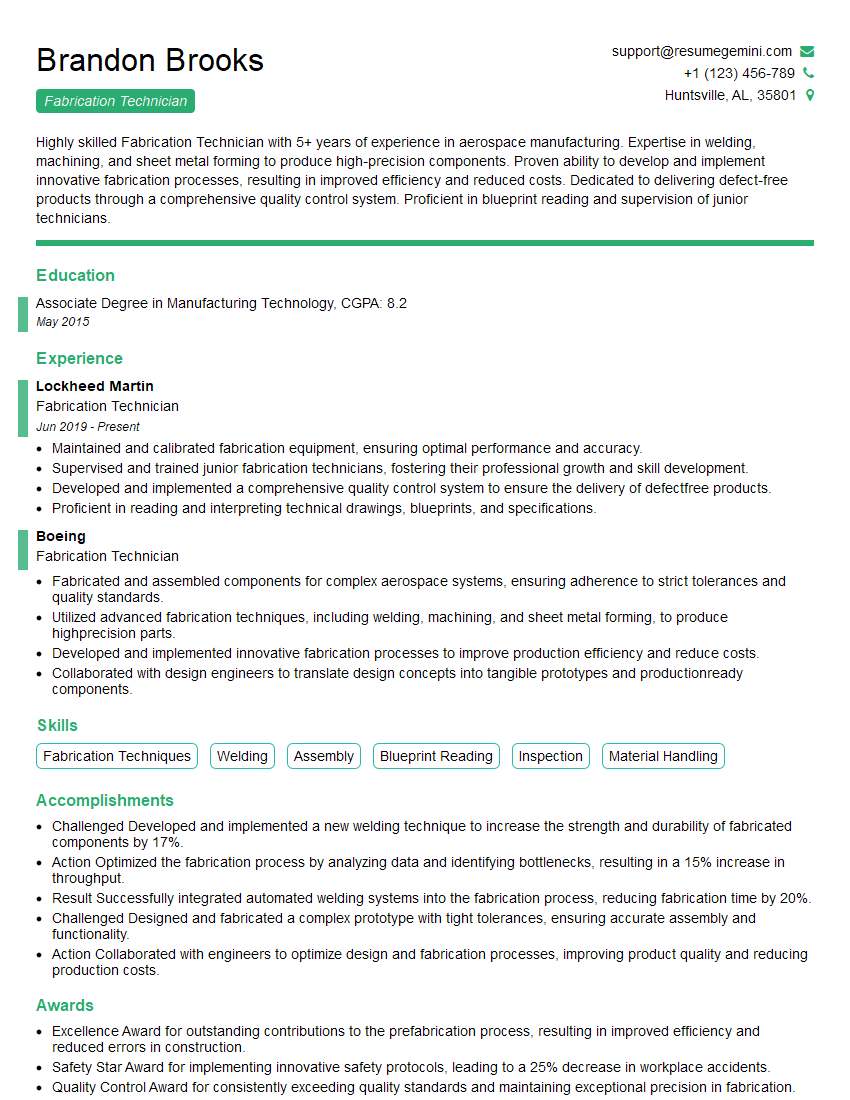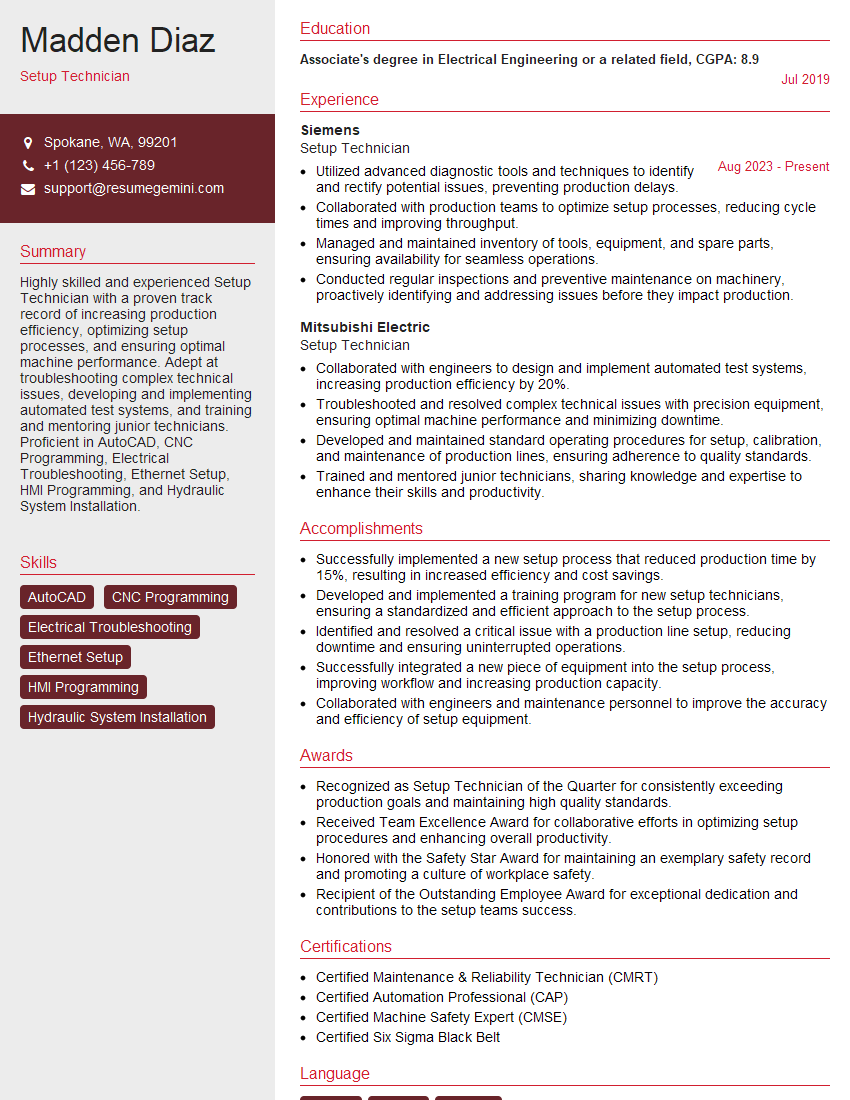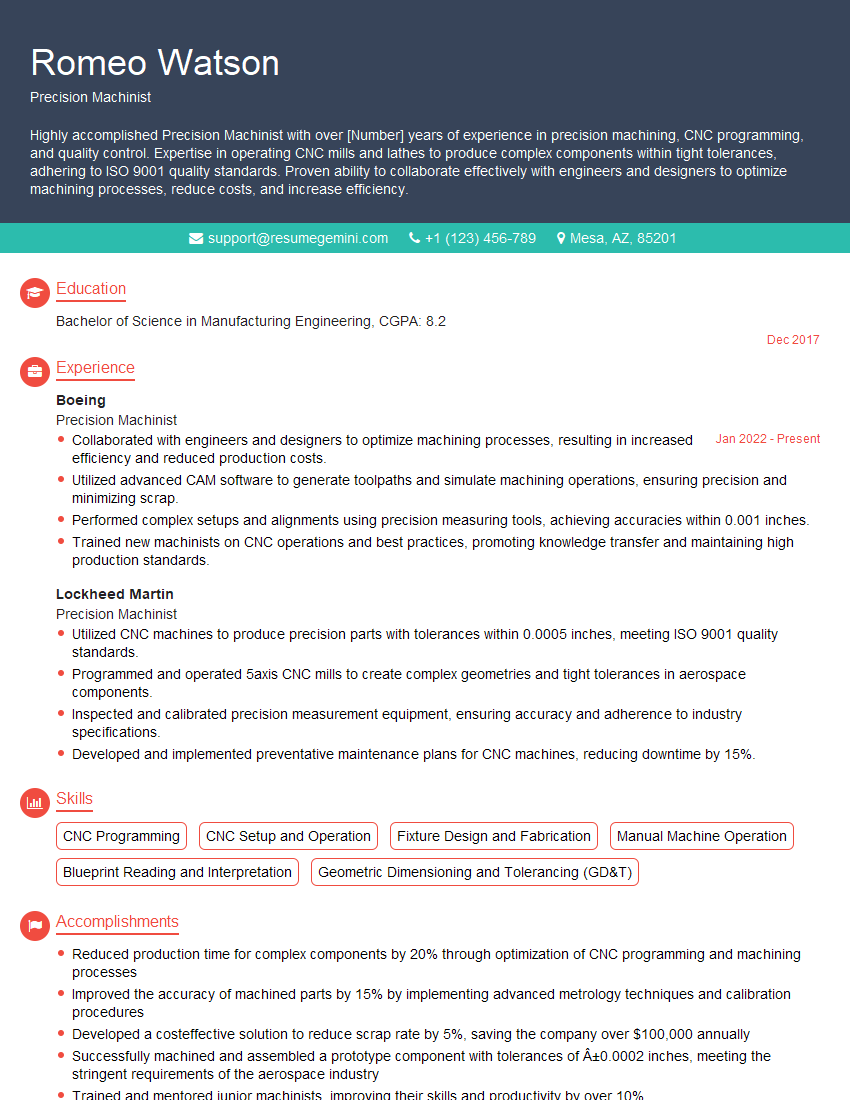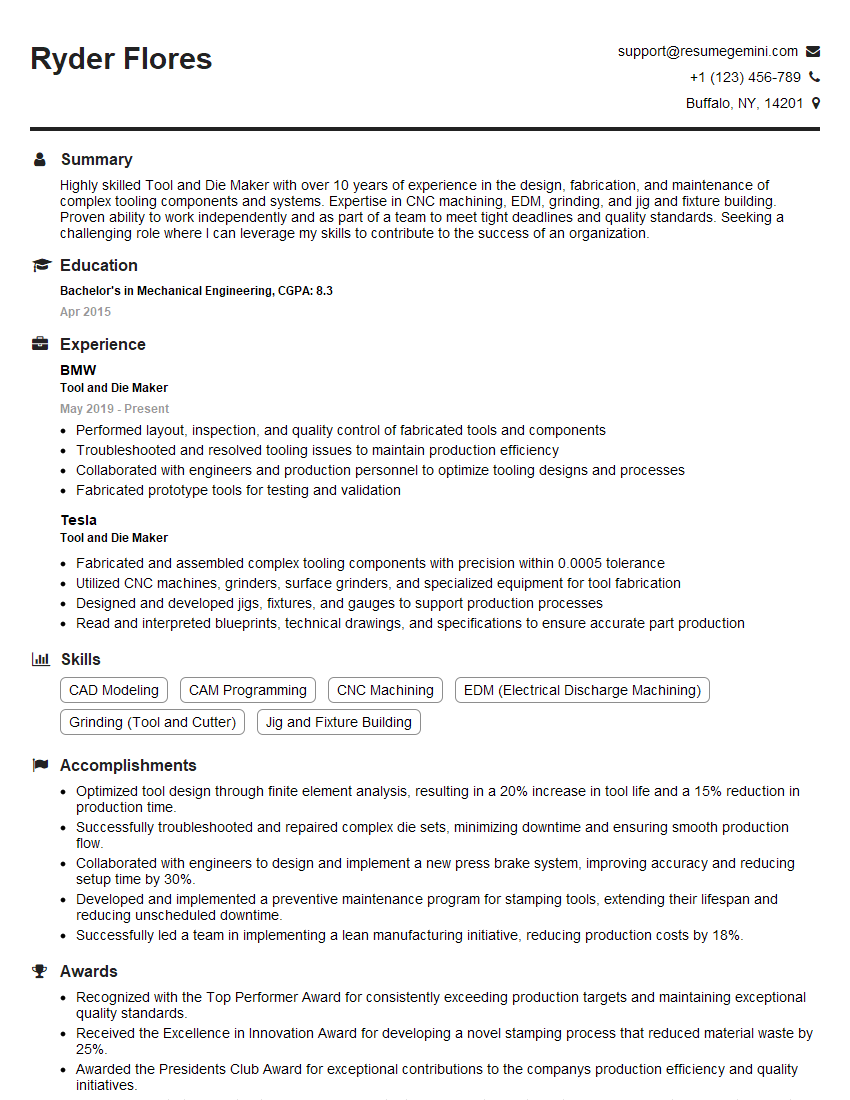Cracking a skill-specific interview, like one for Experience with various types of cutting tools, requires understanding the nuances of the role. In this blog, we present the questions you’re most likely to encounter, along with insights into how to answer them effectively. Let’s ensure you’re ready to make a strong impression.
Questions Asked in Experience with various types of cutting tools Interview
Q 1. Explain the differences between high-speed steel (HSS), carbide, and ceramic cutting tools.
High-speed steel (HSS), carbide, and ceramic cutting tools represent a progression in cutting tool technology, each offering a unique balance of properties. Think of it like choosing the right tool for a specific job – a hammer for nails, a screwdriver for screws.
- HSS: High-speed steel is a versatile and relatively inexpensive material. It’s tough and can withstand high temperatures, making it suitable for a wide range of materials and applications. However, its wear resistance is lower than carbide or ceramic, leading to shorter tool life when machining harder materials or at high speeds. Think of it as your trusty ‘all-arounder’ tool.
- Carbide: Carbide tools are significantly harder and more wear-resistant than HSS. This allows for higher cutting speeds, feeds, and depths of cut, resulting in increased productivity. However, they are more brittle than HSS and can chip or fracture if subjected to excessive forces or impacts. They are the workhorses for many applications demanding both speed and precision.
- Ceramic: Ceramic cutting tools are the hardest and most wear-resistant of the three. They excel in machining very hard and abrasive materials, like hardened steel or titanium alloys, at extremely high speeds. But their high brittleness makes them susceptible to damage, requiring careful handling and potentially limiting their application range. Think of ceramics as specialists for tackling the toughest materials.
In summary: HSS offers versatility and affordability, carbide provides a balance of performance and cost-effectiveness, and ceramic excels in extreme hardness applications, but at a higher cost and with increased fragility.
Q 2. Describe the various types of cutting tool geometries and their applications.
Cutting tool geometry refers to the shape and angles of the cutting edges and the tool body. These geometries are meticulously designed to optimize the cutting process and achieve desired results like surface finish, cutting forces, and tool life. Consider it akin to sculpting – the shape of your chisel determines how effectively you can carve.
- Rake Angle: The angle between the face of the cutting tool and the direction of machining. A positive rake angle promotes better chip flow and reduces cutting forces, while a negative rake angle enhances strength and stability.
- Relief Angle: The angle between the flank of the tool and the machined surface. It determines how much clearance the tool has, influencing cutting forces and friction.
- Nose Radius: The radius at the tip of the cutting tool. It affects the surface finish and strength of the cutting edge; a larger radius generally leads to a smoother finish but may reduce tool life.
- Cutting Edge Length: Influences the depth of cut that can be used.
- Chip Breaker: Built-in features to control chip formation for safety and process stability.
Different machining operations require different geometries. For example, turning operations might utilize a positive rake angle for smoother cutting, while milling operations may use negative rake angles for greater stability in heavier cuts.
Q 3. How do you select the appropriate cutting tool for a specific material and machining operation?
Selecting the right cutting tool is critical for efficient and productive machining. This involves considering several factors, almost like choosing the right ingredients for a recipe.
- Material to be machined: The hardness, toughness, and abrasiveness of the workpiece dictate the required tool material (HSS, carbide, ceramic) and geometry. Machining titanium requires a completely different approach compared to aluminum.
- Machining operation: Turning, milling, drilling, each requires specific tool geometries designed for optimal performance. A drill bit is useless for turning.
- Desired surface finish: The required surface roughness influences the choice of tool nose radius and cutting parameters.
- Machining parameters (Cutting speed, feed rate, depth of cut): The selected tool must withstand the cutting forces generated.
- Machine tool capabilities: The machine’s power and rigidity influence the maximum cutting forces that can be applied.
A systematic approach, including consulting tool manufacturers’ recommendations and utilizing material selection guides, is crucial. For instance, a carbide insert with a sharp nose radius is ideal for a high-speed finishing operation on steel, while a HSS tool with a larger nose radius might be more suitable for roughing a softer material like aluminum.
Q 4. What are the factors that influence tool life and how can you extend it?
Tool life, simply put, is the time a cutting tool can operate before it needs replacement or resharpening. Many factors affect it, and extending it is crucial for maximizing productivity and minimizing costs. It’s like maintaining your car – regular upkeep extends its lifespan.
- Cutting speed, feed rate, and depth of cut: Higher values generally reduce tool life but increase material removal rate. Finding the optimal balance is key.
- Workpiece material: Harder and more abrasive materials cause faster wear.
- Cutting fluid: Proper lubrication and cooling extend tool life by reducing friction and heat generation.
- Tool material: Higher-grade materials (e.g., coated carbide) offer extended tool life.
- Tool geometry: Properly designed geometry contributes to efficient chip removal and reduced wear.
- Machine tool condition: Vibration and chatter significantly reduce tool life.
Extending tool life can be achieved through optimizing cutting parameters, using appropriate cutting fluids, ensuring proper tool clamping, and maintaining machine tool precision. Regular inspection and preventive maintenance of machines are also crucial.
Q 5. Explain the concept of cutting speed, feed rate, and depth of cut.
Cutting speed, feed rate, and depth of cut are the three fundamental parameters controlling the machining process. Imagine them as the three legs of a stool – all three are necessary for stability and optimal performance.
- Cutting speed (V): The surface speed of the cutting tool measured in meters per minute (m/min) or feet per minute (fpm). A higher cutting speed removes more material per unit of time, but it can also lead to increased wear.
- Feed rate (f): The rate at which the tool advances into the workpiece per revolution or per minute (mm/rev or mm/min). A higher feed rate means more material is removed per pass, but it can also result in higher cutting forces and reduced surface finish.
- Depth of cut (d): The distance the tool penetrates into the workpiece in a single pass (mm). A deeper cut removes more material, but it increases cutting forces and can lead to tool breakage if excessive.
Optimizing these parameters is critical for balancing productivity and tool life. For example, a roughing operation may utilize a high depth of cut and feed rate for fast material removal, while a finishing operation might utilize a lower depth of cut and feed rate to achieve a high-quality surface finish.
Q 6. How do you identify and address tool wear?
Identifying and addressing tool wear is crucial for maintaining machining quality and preventing catastrophic tool failures. Regular monitoring is essential, much like checking your body’s health for early signs of illness.
- Visual Inspection: Regular checks for signs of wear, such as chipping, cracks, flank wear, crater wear, and edge build-up.
- Measurement: Using tools like optical microscopes and measuring instruments to quantify wear patterns.
- Tactile Inspection: Running a finger across the cutting edge can help identify wear.
Addressing tool wear might involve resharpening (for HSS tools), replacing worn inserts (for carbide and ceramic tools), or adjusting cutting parameters to compensate for mild wear. Ignoring tool wear can lead to poor surface finish, dimensional inaccuracies, and ultimately, tool breakage, resulting in costly downtime and potential machine damage.
Q 7. What are the different types of tool holders and their applications?
Tool holders securely clamp cutting tools to the machine spindle, transmitting cutting forces and providing stability. The choice of tool holder depends on the machining operation and the type of cutting tool being used. It’s like choosing the right mounting system for a piece of art – you need the right support.
- Collet Chucks: Used for smaller diameter tools, offering quick tool changes. Think of a spring-loaded clamp.
- Drill Chucks: Designed specifically for holding drills; they’re very common in most workshops.
- Machine Tool Holders: This broader category includes various designs like shell mill holders, end mill holders, boring bars, and more, each tailored to specific tool geometries and machining operations.
- Hydraulic Chucks: Offer high clamping forces, typically used for larger and heavier cutting tools.
- Modular Tool Holders: These systems offer flexibility, allowing the user to combine different components (shanks, adapters, etc.) to adapt to different machines and tool sizes.
Selecting the appropriate tool holder is critical for ensuring safe and reliable operation. An improperly secured tool can lead to vibrations, reduced accuracy, and ultimately tool failure, posing a risk to both the machine and the operator.
Q 8. Describe the process of setting up and operating a CNC machine with various cutting tools.
Setting up and operating a CNC machine with various cutting tools is a multi-step process requiring precision and understanding of both the machine and the tools. It begins with selecting the appropriate tool for the material and desired finish. This involves consulting tool specifications and datasheets (discussed later). Once the tool is chosen, the next steps are:
- Tooling Setup: The chosen cutting tool is carefully mounted into the CNC machine’s spindle. This often involves using a collet, a chuck, or other specialized clamping mechanism. It’s crucial to ensure the tool is firmly secured and precisely aligned to prevent vibrations and inaccuracies during machining. Incorrect clamping can lead to catastrophic tool failure.
- Workpiece Setup: The workpiece is then secured onto the machine’s table or fixture. This requires careful consideration of the workpiece geometry and the machining operation. Proper clamping is essential to prevent movement during cutting, which can result in damaged parts or even machine damage. We often use vises, clamps, or specialized fixtures depending on the workpiece.
- Program Execution: A CNC program, usually written in G-code, dictates the toolpath and cutting parameters (feed rate, spindle speed, depth of cut). This program is loaded into the machine’s control system and verified for accuracy before initiating the machining process. Simulations are often run to predict tool movement and check for collisions.
- Monitoring and Adjustment: During the machining process, the operator monitors the machine’s performance, listening for unusual sounds, observing the cutting action and chip formation. If needed, minor adjustments to the program or feed rates might be necessary to optimize the process and maintain high quality.
- Tool Change (if needed): For complex parts requiring multiple tools, the CNC machine is programmed to automatically change tools. This automated change is crucial for efficiency and often involves a robotic arm that picks up the used tool and replaces it with the next one from a tool magazine. The machine will then resume machining with the new tool based on the programmed instructions.
For example, while machining a complex aluminum part, I once had to use a series of end mills, drills, and a reamer to create a precise hole pattern. Each tool required careful setup and its own set of parameters to ensure the accuracy and surface finish were maintained throughout the entire process.
Q 9. How do you troubleshoot common cutting tool problems?
Troubleshooting cutting tool problems requires a systematic approach. It begins with careful observation and then proceeds to diagnose and rectify the issue. Common problems include:
- Tool breakage: This often indicates excessive cutting forces, improper tool clamping, or a dull tool. Checking the program parameters (feed rate, depth of cut, spindle speed) is crucial. I also always check for any hidden obstructions that could be causing collisions.
- Poor surface finish: This can result from dull tools, incorrect cutting parameters (feed rate, spindle speed), or inadequate coolant supply. Examining the tool’s condition and adjusting the cutting parameters often resolves this. I also double-check if the tool is correctly positioned.
- Tool chatter: This high-frequency vibration causes poor surface finish and can damage the tool. It usually stems from improper setup (poor clamping or workpiece rigidity), resonance at certain spindle speeds, or a dull tool. Adjusting cutting parameters, increasing workpiece clamping force, and changing spindle speed can help resolve this. In severe cases, a different tool path might be necessary.
- Tool deflection: This can lead to inaccuracies in the machined part and is usually caused by a tool that is too long or slender, an insufficiently rigid workpiece, or excessive cutting forces. A solution could be using a shorter or stiffer tool, improving workpiece support or reducing the depth of cut.
A systematic approach, combined with experience, is essential for effective troubleshooting. I always start with the simplest solutions, such as checking the tool clamping, examining the tool itself for defects, and ensuring the correct cutting parameters are set before moving to more complex issues.
Q 10. What are the safety precautions involved in using cutting tools?
Safety is paramount when working with cutting tools. Here are some essential precautions:
- Personal Protective Equipment (PPE): Always wear appropriate safety glasses, hearing protection, and cut-resistant gloves. Depending on the material being machined, a face shield or even a respirator might be necessary.
- Machine guarding: Ensure all machine guards are in place and functioning correctly. These guards prevent accidental contact with moving parts. Never operate a machine without proper guarding.
- Proper Clothing: Avoid loose clothing, jewelry, or long hair that could get caught in moving parts. Proper work attire minimizes risks of accidents.
- Lockout/Tagout Procedures: Always follow lockout/tagout procedures before performing any maintenance or repairs on the machine. This prevents unexpected starts.
- Emergency Stop Button: Know the location of the emergency stop button and how to use it. Regularly check its functionality.
- Fire Safety: Be aware of fire hazards associated with certain machining operations, and have appropriate fire extinguishers readily available.
- Coolant Handling: Properly handle coolants according to their safety data sheets. Some coolants are hazardous and require special precautions.
One time, I witnessed a colleague forget to wear safety glasses, resulting in a small metal chip hitting their eye. It served as a harsh reminder of the importance of always wearing PPE. Complacency can lead to serious injuries.
Q 11. Explain the importance of proper tool clamping and its impact on machining accuracy.
Proper tool clamping is critical for machining accuracy. The tool must be held securely and precisely aligned to prevent vibrations and ensure the intended cutting action. Insufficient clamping can lead to:
- Tool deflection: Causing inaccurate cuts and poor surface finish.
- Tool chatter: Leading to vibrations and potentially tool breakage.
- Inconsistent cuts: Resulting in scrapped parts or rework.
- Premature tool wear: Reducing tool life and increasing costs.
The clamping force must be sufficient to hold the tool firmly but not so excessive that it damages the tool or the machine. Different tools require different clamping methods. Collets are typically used for smaller tools, while chucks are used for larger tools. Regular inspection of the clamping mechanism is important to ensure it is in good working condition.
For instance, during a precision milling operation on a titanium component, I once experienced tool chatter due to insufficient clamping force. By tightening the collet appropriately, we eliminated the chatter and achieved the desired surface finish.
Q 12. How do you measure cutting tool wear and determine when to replace a tool?
Measuring cutting tool wear is crucial for maintaining machining accuracy and preventing tool failures. Several methods are used:
- Visual Inspection: Regularly inspect the tool for chipping, cracking, or excessive wear on the cutting edges. This is often the first indicator of wear.
- Measuring Tool Dimensions: Use a micrometer or other precision measuring instrument to check the tool’s dimensions against its original specifications. A reduction in tool diameter or length indicates wear.
- Tool Wear Sensors: Some CNC machines have built-in tool wear sensors that monitor tool vibration or cutting forces. These sensors provide real-time feedback on tool condition.
- Edge Detection Systems: Advanced systems utilize optical or other sensors to monitor the sharpness of the tool’s cutting edge.
The decision to replace a tool depends on several factors, including the amount of wear, the type of machining operation, and the required tolerances. Replacing a worn tool is essential to maintaining part quality and machine performance. A general rule of thumb is to replace a tool once its wear exceeds a certain percentage of its original dimensions or when it begins to affect the quality of the machined part, even if wear is not yet significant. It’s also good practice to have a stock of replacement tools so that machining can continue without interruption.
Q 13. Describe your experience with different types of coolant and their applications in machining.
Coolants play a vital role in machining, improving performance and extending tool life. Different coolants are suited for various applications:
- Water-Based Coolants: These are the most common and are relatively inexpensive. They provide good cooling and lubrication, but can promote rust and corrosion in certain materials. They are suitable for most metals.
- Oil-Based Coolants: Offer excellent lubrication and are better for materials prone to rust. However, they are more expensive and can be messy.
- Synthetic Coolants: These are environmentally friendly and typically offer good cooling and lubrication. They often have a longer shelf life than other coolants.
- MQL (Minimum Quantity Lubrication): This technique uses a very small amount of lubricant, often delivered through an aerosol system. It provides targeted lubrication and cooling, reducing environmental impact and coolant usage. It is particularly useful for high-speed machining operations.
The choice of coolant depends on the material being machined, the type of machining operation, and environmental considerations. For example, when machining stainless steel, I often use a water-based coolant with a rust inhibitor. For high-speed machining of aluminum, I prefer a synthetic coolant or MQL.
Q 14. How do you interpret cutting tool specifications and datasheets?
Cutting tool specifications and datasheets provide critical information about a tool’s capabilities and limitations. Understanding these specifications is crucial for selecting the right tool and setting appropriate machining parameters. Key information includes:
- Tool Geometry: This includes the tool’s cutting angles, the number of flutes, and the overall dimensions. Different geometries are optimized for different machining operations.
- Material: The tool material (e.g., carbide, high-speed steel, ceramic) greatly affects its performance, durability, and suitability for specific materials.
- Coating: Many tools have coatings (e.g., TiN, TiAlN) that improve their wear resistance, reduce friction, and enhance performance. The specific coating dictates the suitability for certain materials or operations.
- Recommended Cutting Parameters: Datasheets provide recommended ranges for feed rate, spindle speed, and depth of cut. These parameters must be carefully chosen to optimize the machining process and prevent tool failures.
- Tolerances: These specifications describe the level of accuracy achievable with the tool. For precise applications, tools with tighter tolerances are required.
For example, when choosing a carbide end mill to machine hardened steel, I would carefully examine the datasheet to ensure it specifies suitability for the material. I would also pay close attention to the recommended cutting parameters and the type of coating to achieve the desired surface finish and prevent premature tool wear. Ignoring these specifications can lead to tool breakage, poor surface finish, or inaccurate parts.
Q 15. What are the different types of coatings used on cutting tools and their benefits?
Cutting tool coatings significantly enhance their performance and lifespan. Think of them as a protective shield and performance booster for your tools. Different coatings offer various benefits depending on the application and material being machined.
Titanium Nitride (TiN): A common and relatively inexpensive coating, TiN offers good wear resistance, high hardness, and good oxidation resistance. It’s excellent for general-purpose machining of steels and cast irons. Think of it as the ‘workhorse’ coating.
Titanium Carbonitride (TiCN): Offers improved wear resistance compared to TiN, particularly at higher cutting speeds. It’s a good choice when you need a bit more toughness and can handle slightly more demanding applications.
Titanium Aluminum Nitride (TiAlN): Provides even higher hardness and oxidation resistance than TiCN, making it suitable for high-temperature machining applications and difficult-to-machine materials like stainless steel and nickel-based alloys. This is your ‘heavy-duty’ option.
Diamond-like Carbon (DLC): Offers exceptional lubricity and low friction, resulting in extended tool life and improved surface finish. It’s particularly useful for finishing operations and machining non-ferrous materials like aluminum.
Ceramic Coatings: Such as Aluminum Oxide (Al2O3) or Cubic Boron Nitride (CBN), are used for extremely hard materials like hardened steels, ceramics, and superalloys. These coatings provide exceptional wear resistance and can withstand very high temperatures.
The choice of coating depends heavily on the material being machined, the cutting parameters (speed, feed, depth of cut), and the desired surface finish. In my experience, selecting the right coating can easily double or even triple the lifespan of a cutting tool.
Career Expert Tips:
- Ace those interviews! Prepare effectively by reviewing the Top 50 Most Common Interview Questions on ResumeGemini.
- Navigate your job search with confidence! Explore a wide range of Career Tips on ResumeGemini. Learn about common challenges and recommendations to overcome them.
- Craft the perfect resume! Master the Art of Resume Writing with ResumeGemini’s guide. Showcase your unique qualifications and achievements effectively.
- Don’t miss out on holiday savings! Build your dream resume with ResumeGemini’s ATS optimized templates.
Q 16. How do you manage cutting tool inventory and maintain an organized tool crib?
Maintaining an organized tool crib is crucial for efficiency and safety. I’ve found a combination of strategies to be most effective. Firstly, a well-defined system for tool identification and storage is essential. This includes clear labeling, standardized storage locations, and a robust inventory management system (either manual or software-based).
Secondly, regular inventory checks are key – I typically do this weekly or monthly, depending on the tool usage. This helps to identify low-stock items and prevent production downtime. Damaged or worn-out tools are immediately removed and replaced.
Thirdly, the crib should be clean, well-lit, and ergonomically designed to facilitate easy access and retrieval of tools. This includes proper shelving, drawers, and potentially tool dispensing systems for frequently used items. Finally, I also make sure to implement visual management techniques; color-coded systems for different tool types and clearly marked locations for all tools. This ensures that even new team members can easily locate and put away tools.
In my previous role, we implemented a simple barcoding system for tracking tool usage and location. This significantly improved our inventory management and reduced the risk of tool loss or misplacement. We saw a direct improvement in productivity because engineers knew exactly where to find the tools they needed.
Q 17. Describe your experience with different types of chipbreakers and their purpose.
Chipbreakers are integral to efficient machining. Their purpose is to control the formation and flow of chips, preventing them from welding to the tool, building up on the workpiece, or causing damage to the machine or the operator. Different types are suited for different materials and cutting conditions.
Land-type chipbreakers: These are simple, often formed by the geometry of the cutting edge itself. They are effective for relatively brittle materials and moderate cutting speeds.
Built-up chipbreakers: These are added features on the tool, often through mechanical means or brazing. They provide more controlled chip breaking, especially for ductile materials.
Nicks and grooves: These are strategically placed indentations on the tool face to promote chip fracture at regular intervals, preventing long, continuous chips. The design and size of these features are material dependent.
Wavy chipbreakers: Designed to create smaller, more manageable chips which often result in improved surface finish. These are useful for both ductile and less ductile materials.
Selecting the appropriate chipbreaker is crucial. In my experience, using an unsuitable chipbreaker can lead to long, continuous chips that can wrap around the tool, causing breakage, or can reduce productivity by requiring frequent tool changes. The shape, size, and type of chipbreakers also impacts the cutting forces generated. In some materials, improperly selected chipbreakers can even lead to adverse surface finish.
Q 18. How do you calculate cutting parameters for different machining operations?
Calculating cutting parameters involves determining the optimal values for cutting speed (V), feed rate (f), and depth of cut (d) for a given machining operation. These values are interdependent and affect machining time, tool life, surface finish, and power consumption. There’s no single formula, but rather a process involving consideration of several factors.
The process generally involves:
Material Selection: The machinability of the workpiece material is crucial. Different materials require different cutting parameters; harder materials generally require lower cutting speeds and feeds.
Tool Selection: The geometry, material, and coating of the cutting tool significantly impact the optimal cutting parameters. A tool designed for roughing will likely have different optimal parameters compared to one designed for finishing.
Machining Operation: Turning, milling, drilling, and other operations have different parameter ranges that affect the optimal cutting parameters.
Machine Capabilities: The machine’s power, rigidity, and spindle speed range will also limit the possible parameters.
Empirical Data and Machining Handbooks: Machining handbooks and manufacturer’s recommendations provide valuable data and guidelines to start with.
Trial and Error/Optimization: Often, some experimentation is necessary to find the optimal parameters. Starting with conservative values and gradually increasing them while observing surface finish, tool wear, and power consumption is essential.
For example, when turning stainless steel, I might start with a lower cutting speed and feed than for mild steel. Detailed calculations frequently utilize cutting tool manufacturers’ software which has the capability to take multiple variables into consideration.
Q 19. What is the significance of surface finish in machining and how does the cutting tool impact it?
Surface finish is a critical aspect of machining, impacting both the aesthetic appeal and the functional performance of the workpiece. A smooth surface is often desirable to reduce friction, improve fatigue strength, or enhance corrosion resistance. The cutting tool plays a major role in determining the surface finish.
Factors influencing surface finish include:
Tool Geometry: The sharpness of the cutting edge, nose radius, and rake angle significantly impact surface roughness. A sharper tool generally produces a smoother finish. A larger nose radius results in a more rounded surface and less roughness.
Cutting Parameters: Lower cutting speeds and feeds generally result in smoother surfaces. High cutting speeds and feeds often create rougher finishes because of vibration or other cutting-related factors.
Tool Wear: As the tool wears, the surface finish deteriorates. A worn tool will often produce a rougher surface with more chatter and surface inconsistencies.
Workpiece Material: The ductility and machinability of the workpiece material affect the surface finish. Brittle materials tend to produce rougher surfaces than ductile materials.
Cutting Fluid: A proper cutting fluid can lubricate the cutting zone, minimize friction, and reduce surface roughness.
In practice, I often adjust cutting parameters to achieve the desired surface finish. For example, if a very smooth finish is required, I might use a sharper tool, lower cutting speed and feed, and an appropriate cutting fluid. I’ve observed that even minor changes in these factors can result in noticeable changes in the surface roughness.
Q 20. Explain the concept of tool presetting and its importance in machining accuracy.
Tool presetting involves accurately measuring and setting the cutting tool’s position relative to the machine’s coordinate system before the machining process begins. This is crucial for ensuring dimensional accuracy and repeatability in machining. Think of it as setting the stage perfectly before the performance begins.
The importance of tool presetting stems from:
Enhanced Accuracy: By precisely positioning the tool, errors caused by manual tool setting are eliminated, leading to more accurate machined parts.
Improved Repeatability: Presetting ensures that the same tool positions can be consistently replicated across multiple parts, improving consistency and reducing variations between parts.
Reduced Setup Time: Presetting reduces the time spent on machine setup, allowing for quicker changeovers and faster production cycles. The time saved in this process increases efficiency greatly.
Enhanced Safety: Presetting minimizes the risk of tool collisions during machining, contributing to a safer working environment.
Improved Tool Life: Presetting allows for better tool alignment, which may contribute to improved tool life.
In my experience, using a presetter is a non-negotiable element for achieving high-precision machining. I’ve observed a significant reduction in scrap rates and an increase in overall production efficiency when presetting tools, versus the traditional methods of setting tools directly on the machine.
Q 21. How do you handle unexpected tool breakage during machining?
Unexpected tool breakage during machining is a common challenge. The immediate response depends on the severity of the situation and the potential for further damage to the machine or workpiece.
Safety First: Immediately stop the machine and ensure the safety of the operator and surrounding personnel. This is absolutely paramount.
Assess the Damage: Examine the extent of the tool breakage, the condition of the workpiece, and any potential damage to the machine. This evaluation helps determine next steps.
Remove Broken Tool Fragments: Carefully remove any broken tool fragments from the machine and workpiece to prevent further damage. The use of proper safety equipment and precautions is necessary during this phase.
Identify the Root Cause: Investigate the cause of the breakage. This could include incorrect cutting parameters, worn-out tools, poor tool quality, or a problem with the machine itself. A detailed analysis is critical for preventing future occurrences.
Replace the Tool and Resume Machining: Once the cause has been identified and addressed, replace the broken tool with a new one, adjust parameters as needed, and resume machining. If there is damage to the machine, that must be rectified before continuing.
Documentation: Record the incident, the root cause, and the corrective actions taken. This documentation helps prevent similar occurrences in the future.
One particular incident I recall involved a tool breaking due to excessive cutting speed. Through a thorough investigation, we identified the issue in our CAM programming. After correcting the parameters, we didn’t experience that type of failure again. A detailed post-incident review is essential for continuous improvement.
Q 22. Describe your experience with different types of material removal rates and their impact on production.
Material Removal Rate (MRR) is a crucial metric in manufacturing, representing the volume of material removed per unit of time. It’s directly tied to production efficiency and cost. Higher MRR generally means faster production, but it’s a complex relationship influenced by many factors.
My experience encompasses a wide range of MRR scenarios, from low-speed, high-feed machining of tough alloys where controlled MRR prevents tool wear and ensures surface quality, to high-speed, light-feed operations on softer materials prioritizing speed and output. I’ve worked with various cutting tool materials and geometries to optimize MRR for specific applications. For instance, when machining titanium alloys, which are known for their strength and tendency to gall, we opted for a lower MRR strategy with specialized coated carbide tools and cryogenic cooling to maintain tool life and surface finish. In contrast, when machining aluminum, we used high-speed steel tools with aggressive feed rates to achieve a high MRR, significantly reducing production time.
Understanding the impact of MRR on production involves considering factors like tool wear, power consumption, surface finish, and dimensional accuracy. A high MRR might seem desirable, but exceeding the tool’s capabilities can lead to premature failure, requiring tool changes, machine downtime, and potentially scrapped parts. Therefore, achieving the optimal MRR requires careful consideration of the material being machined, the cutting tool, the machining parameters (speed, feed, depth of cut), and the desired surface finish and dimensional tolerance.
Q 23. What are the advantages and disadvantages of using solid carbide versus indexable inserts?
Solid carbide and indexable inserts are both common cutting tool materials, each with its own set of advantages and disadvantages.
- Solid Carbide: Solid carbide tools are made from a single piece of carbide. They offer excellent wear resistance, high hardness, and good dimensional stability. They are ideal for high-precision applications and machining hard materials. However, they are more expensive than indexable inserts and are not as easily replaceable when worn out. Once dull, the entire tool needs replacing, leading to increased costs.
- Indexable Inserts: These are small, replaceable cutting edges that are brazed or mechanically clamped into a tool holder. Their primary advantage is cost-effectiveness; when the insert is worn, only the insert needs replacement, significantly reducing downtime and costs. They also offer greater versatility as different inserts can be used to optimize for various materials and operations. However, inserts can sometimes exhibit less rigidity than solid carbide tools, potentially impacting accuracy in certain demanding applications.
The choice between solid carbide and indexable inserts depends heavily on the application. For high-volume production runs with readily replaceable inserts, indexable inserts are often preferred. For intricate machining or high-precision work requiring excellent rigidity and tool life where cost is less critical, solid carbide is frequently the better option.
Q 24. How do you ensure the quality of your work when using cutting tools?
Ensuring quality when using cutting tools is a multi-faceted process. It begins with proper tool selection based on material properties, machining operation, and desired surface finish. This includes considerations for coatings, geometry, and insert grade.
- Tool condition monitoring: Regularly inspecting tools for wear, chips, or damage is crucial. I use various methods including visual inspection under magnification and sometimes measuring tool dimensions.
- Proper clamping: Ensuring the cutting tool is securely and accurately clamped in the machine spindle is essential to prevent vibration and chatter, which can lead to poor surface finish and dimensional inaccuracies.
- Machining parameter optimization: Selecting the correct speed, feed, and depth of cut for the material and tool is paramount. Incorrect parameters can lead to rapid tool wear, poor surface finish, and even tool breakage.
- Workpiece setup and fixturing: Precisely positioning and clamping the workpiece is critical. Improper fixturing can lead to vibrations, inaccurate cuts, and potentially damaged tools.
- Regular machine maintenance: Regular machine maintenance ensures the machine’s accuracy and stability, minimizing the likelihood of issues related to vibrations or inaccuracies during the cutting operation.
- Post-process inspection: Thorough inspection of the finished part using CMM (Coordinate Measuring Machine) or other suitable measuring equipment, to ensure it meets specifications.
By meticulously following these steps, I can consistently achieve high-quality results and minimize waste.
Q 25. What software programs are you familiar with for designing or simulating cutting tool applications?
I’m proficient in several software packages used for designing and simulating cutting tool applications. My experience includes:
- Mastercam: This CAD/CAM software is widely used for generating CNC toolpaths for various machining operations. I use it extensively for designing complex toolpaths, optimizing cutting parameters, and verifying toolpath accuracy.
- CATIA: I’ve used CATIA for 3D modeling and simulation of machining processes, allowing for virtual testing of toolpaths and identification of potential problems before actual machining.
- NX CAM: Similar to Mastercam and CATIA, NX CAM enables detailed simulation of cutting operations to optimize efficiency and minimize tool wear.
- FeatureCAM: This software is excellent for automated feature recognition and programming, allowing efficient generation of CNC code for complex parts.
These software packages allow for the creation of accurate toolpaths, the simulation of the machining process, and optimization of machining parameters, ultimately leading to improved productivity and reduced production costs.
Q 26. Describe your experience with different types of drilling, milling, and turning operations.
My experience spans a broad range of drilling, milling, and turning operations.
- Drilling: I have experience with various drilling techniques including deep-hole drilling, trepanning, and high-speed drilling of diverse materials, ranging from aluminum and plastics to hardened steels and titanium alloys. I understand the importance of selecting appropriate drill bits, speeds, and feeds to minimize burrs, prevent breakage, and achieve precise hole dimensions.
- Milling: I’m proficient in various milling techniques, including face milling, end milling, slot milling, and profile milling. I have experience optimizing cutting parameters for different milling strategies, such as climb milling and conventional milling, to achieve surface finish and dimensional accuracy requirements.
- Turning: My experience includes various turning operations, like facing, grooving, chamfering, and thread cutting. I am skilled in selecting appropriate cutting tools and parameters for different materials and surface finish requirements. I’m familiar with different lathe types and their capabilities.
In each operation, I focus on selecting the right tool for the job, optimizing cutting parameters, and ensuring proper workpiece setup and fixturing for efficient and accurate machining.
Q 27. How do you maintain and calibrate measuring instruments used for checking cutting tools?
Maintaining and calibrating measuring instruments is crucial for accurate work. This involves several steps:
- Regular Cleaning: Keeping instruments clean and free of debris is vital for accurate readings. I use appropriate cleaning solutions and techniques specific to the instrument type.
- Calibration: Calibration is performed using certified standards and traceable to national or international standards. The frequency of calibration depends on the instrument and its usage, but it’s typically done at regular intervals or after any potential impact. For example, micrometers and calipers are calibrated using gauge blocks.
- Verification: After calibration, I verify the calibration results through repeat measurements and check for any discrepancies. This ensures the accuracy of the calibration process itself.
- Documentation: All calibration and verification results are meticulously documented, including date, instrument ID, results, and the technician who performed the calibration. This ensures traceability and accountability.
- Storage: Proper storage of instruments, in a clean, controlled environment, helps to protect them from damage and maintain their accuracy.
Using calibrated and well-maintained instruments ensures the accuracy of measurements and ultimately the quality of the machined parts.
Q 28. Describe a challenging situation you faced involving cutting tools and how you resolved it.
One challenging situation involved machining a complex titanium alloy part with extremely tight tolerances. Initial attempts using standard carbide tools resulted in significant tool wear and unacceptable surface finish, exceeding the tolerance limits. The part’s intricate geometry contributed to vibrations and chatter.
To resolve this, I first analyzed the problem, identifying the root cause as tool wear and chatter due to the material’s hardness and the part’s geometry. My solution involved a multi-pronged approach:
- Tool selection: I switched to specialized, high-performance coated carbide tools with enhanced wear resistance and optimized geometry for titanium machining.
- Cutting parameter optimization: I implemented a more conservative cutting strategy, reducing the cutting speed and feed rates to decrease tool wear and vibrations.
- Workpiece fixturing: I improved the workpiece fixturing system to minimize vibrations and ensure rigidity. This involved using additional clamps and a more robust setup.
- Coolant selection: We experimented with different coolants, ultimately settling on a high-pressure coolant system to improve chip evacuation and reduce cutting temperatures.
By systematically addressing each aspect of the machining process, we significantly improved tool life, surface finish, and dimensional accuracy, successfully meeting the project’s demanding requirements. This experience reinforced the importance of a thorough understanding of material properties, tool selection, and process optimization in achieving successful machining results.
Key Topics to Learn for Experience with various types of cutting tools Interview
- Types of Cutting Tools: Understanding the differences between various cutting tools (e.g., milling cutters, drills, lathe tools, saws) including their geometries, materials, and applications.
- Material Selection and Tooling: Knowing how to select the appropriate cutting tool for a given material and machining operation, considering factors like hardness, machinability, and desired surface finish.
- Cutting Parameters: Mastering the concept of speed, feed, and depth of cut, and their impact on tool life, surface finish, and part accuracy. Understanding how to optimize these parameters for different materials and tools.
- Tool Wear and Maintenance: Recognizing signs of tool wear, understanding the causes of premature tool failure, and implementing proper maintenance procedures to extend tool life and ensure consistent performance.
- Safety Procedures: Demonstrating a thorough understanding of safe operating practices for various cutting tools, including proper machine setup, personal protective equipment (PPE), and emergency procedures.
- Troubleshooting and Problem Solving: Being able to diagnose and resolve common machining problems related to cutting tools, such as broken tools, poor surface finish, or dimensional inaccuracies. This includes understanding the root causes and implementing corrective actions.
- Advanced Machining Techniques: Familiarity with advanced techniques like high-speed machining (HSM), cryogenic machining, and other specialized cutting methods.
Next Steps
Mastering your knowledge of various cutting tools is crucial for advancing your career in manufacturing and related fields. A strong understanding of these concepts demonstrates practical skills and problem-solving abilities highly valued by employers. To significantly improve your job prospects, focus on creating an ATS-friendly resume that highlights your expertise. ResumeGemini is a trusted resource to help you build a professional and impactful resume that showcases your skills effectively. Examples of resumes tailored to highlight experience with various types of cutting tools are available within ResumeGemini to guide your creation process. Take the next step towards your dream career today!
Explore more articles
Users Rating of Our Blogs
Share Your Experience
We value your feedback! Please rate our content and share your thoughts (optional).
What Readers Say About Our Blog
Hi, I’m Jay, we have a few potential clients that are interested in your services, thought you might be a good fit. I’d love to talk about the details, when do you have time to talk?
Best,
Jay
Founder | CEO




